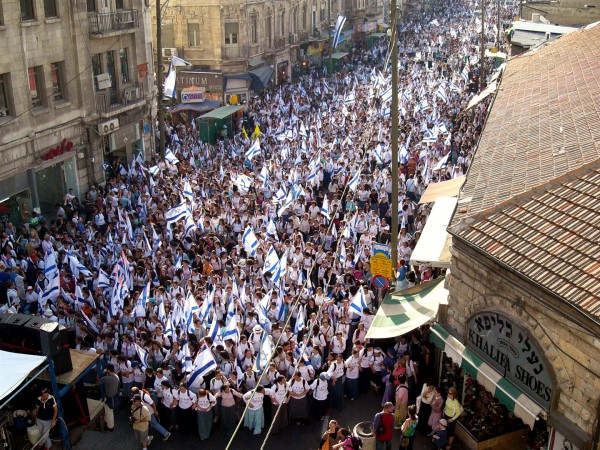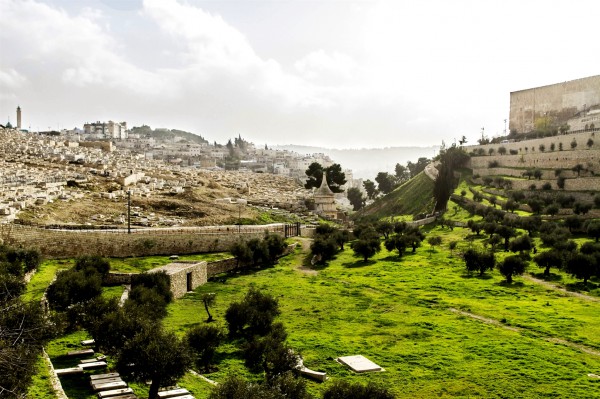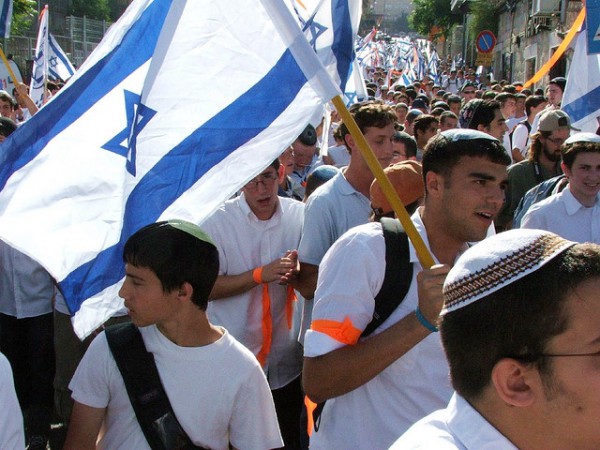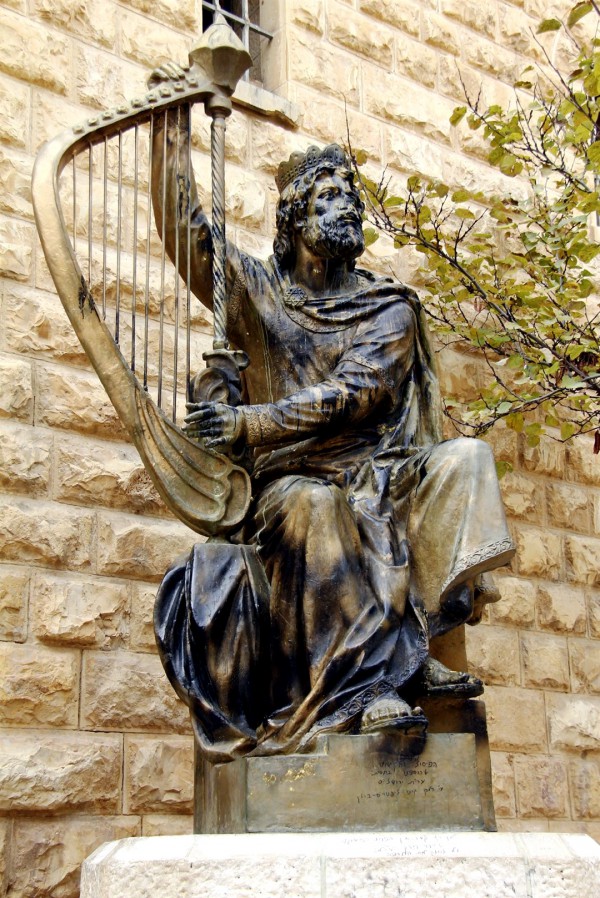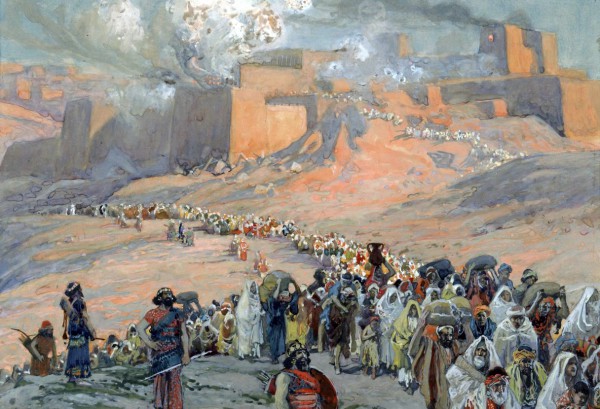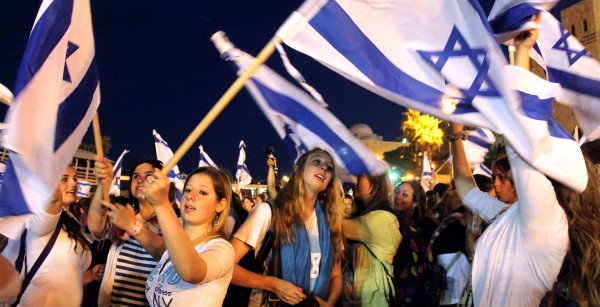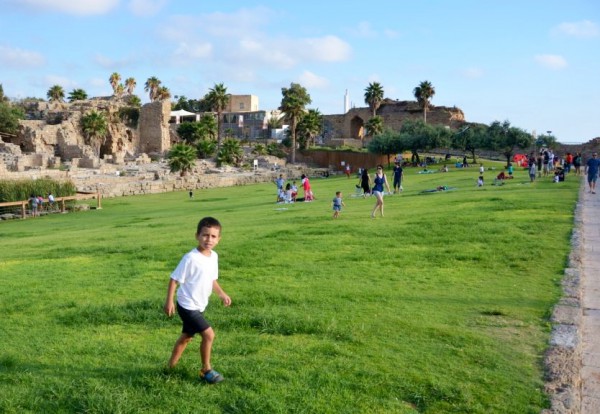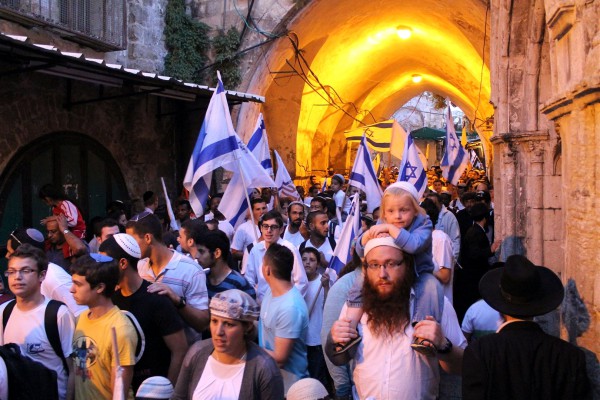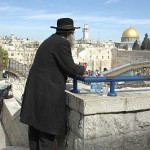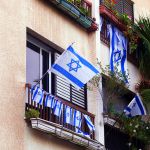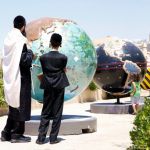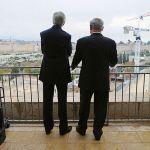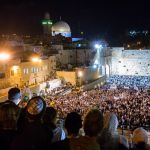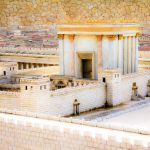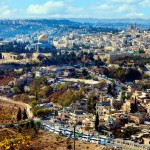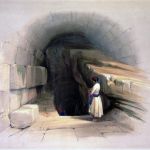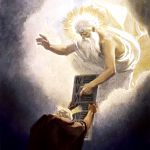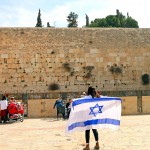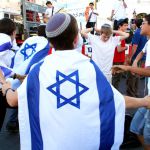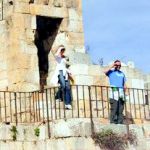“If I forget you, Jerusalem, may my right hand forget its skill. May my tongue cling to the roof of my mouth if I do not remember you, if I do not consider Jerusalem my highest joy.” (Psalm 137:5–6)
On June 5, 2016, the reunification of Jerusalem will be celebrated by crowds parading blue and white through downtown Jerusalem marking Yom Yerushalayim (Jerusalem Day).
It has been almost 50 years since Jerusalem’s Old City, Mount of Olives and Temple Mount were recaptured on the 28th of Iyyar, 1967, during the Six Day War, after Jordan began firing on western Jerusalem.
The young Kingdom of Jordan had occupied eastern Jerusalem, Judea and Samaria for 19 years—its forces put in place after striking hard against the newly independent State of Israel in 1948.
Israel faced forces from Jordan, Syria, Egypt and Lebanon, who were backed in weaponry and finances by Iraq, Saudi Arabia, Kuwait, Sudan, and Algeria. Her impossible victory still cost the nation twice as many men “as the United States lost in eight years of fighting in Vietnam” in proportion to total population. (Jewish Virtual Library)
Sunday’s day of celebration also will feature state ceremonies and memorial services for the 777 Israeli soldiers killed in action during the Six Day War, including almost a quarter of the nation’s 200 Air Force fighters.
Nevertheless, Jerusalem’s miraculous reunification is an important prophetic step paving the way for the King Messiah’s return. Truly, the weight of the City’s prophetic role on Earth makes her “an immovable rock for all the nations” (Zechariah 12:3).
“I will gather all nations and bring them down to the Valley of Jehoshaphat. There I will put them on trial for what they did to My inheritance, My people Israel, because they scattered My people among the nations and divided up My land.” (Joel 3:2)
Jerusalem: The City of Completion
“Speak tenderly to Jerusalem, and proclaim to her that her hard service has been completed, that her sin has been paid for, that she has received from the Lord’s hand double for all her sins. A voice of one calling: ‘In the wilderness prepare the way for the Lord; make straight in the desert a highway for our God.'” (Isaiah 40:2–3)
The unification of Jerusalem is a parallel picture of Jerusalem to come—the City in which the spiritual and physical worlds will unite.
During the Messianic Kingdom, God no longer will be relegated to myth or tradition in the eyes of an unbelieving world, for God has sworn, “My mouth has uttered in all integrity a word that will not be revoked: Before Me every knee will bow; by Me every tongue will swear.” (Isaiah 45:23)
Just as Yeshua (Jesus) rose into Heaven from the Mount of Olives (Acts 1:11), He will descend upon the same in His return to Jerusalem. It will be a commanding demonstration of His power as King Messiah. When His feet touch the mountain, it will split in two (Zechariah 14:4).
With a “roar from Zion and thunder from Jerusalem,” Yeshua will take up His throne in the Holy City, to “be a refuge for His people, a stronghold for the people of Israel.” (Joel 3:16)
Then “the Lord will be king over the whole earth. On that day there will be one Lord, and His name the only name.” (Zechariah 14:9)
Under the direct rulership of the Prince of Peace (Sar Shalom), Jerusalem will assume its divine identity as the City of Peace.
The name Yerushalayim is widely thought to come from two Hebrew words: ir meaning city and shalem (from shalom), meaning peace—City of Peace.
Going deeper, shalem comes from shalmut, meaning to fulfill or complete. So, the City of Peace may also be called the City of Completion. (Aish)
Indeed, it is also thought by many that Jerusalem is where creation began—in perfection—and where all things will return—to perfection.
Imagine! Jerusalem will assume its full potential under the influence of God Himself!
“For the Lord has chosen Zion, He has desired it for his dwelling, saying, ‘This is my resting place forever and ever; here I will sit enthroned, for I have desired it.
‘I will bless her with abundant provisions; her poor I will satisfy with food. I will clothe her priests with salvation, and her faithful people will ever sing for joy. Here I will make a horn grow for David and set up a lamp for my anointed one. I will clothe his enemies with shame, but his head will be adorned with a radiant crown.’” (Psalm 132:13–18)
Jerusalem: How Goes the King, Goes the City
In spite of its name and probably because of its destiny, time and again throughout history the “City of Peace” has fallen into captivity or been attacked.
In the last several years alone, parts of Jerusalem, including the Temple Mount, have been claimed as the heritage of a “displaced Palestinian people”—or as a central holy place to the Islamic religion, completely detached from Jewish connection.
“In 2009, the Palestinian Authority (PA) has initiated an unprecedented campaign of historical revision and anti-Israel libels concerning Jerusalem, the focal point being the erasure and denial of 3,000 years of Jewish history in Jerusalem,” writes Palestinian Media Watch.
“In addition, the PA disseminates the libel that Israel is acting both to expel Arabs from Jerusalem and to destroy the Al-Aqsa Mosque. The Jerusalem libels are designed to evoke religious hatred by portraying Israel and the Jews as a threat to Arabs and Islam.”
In fact, this March, Fatah Revolutionary Council member Bakr Abu Bakr wrote that Netanyahu relies on “the theft and crude falsification of history, based on the assumption that Palestine is the land of his ‘ancestors’—even though [Netanyahu] and those he represents are strangers to this land both now and historically speaking.” (PalWatch: Official PA Daily Al-Hayat Al-Jadida)
PA Chief Justice Tayseer Al-Tamimi also stated that “Jerusalem is the religious, political and spiritual capital of Palestine—the Jews have no right to it.”
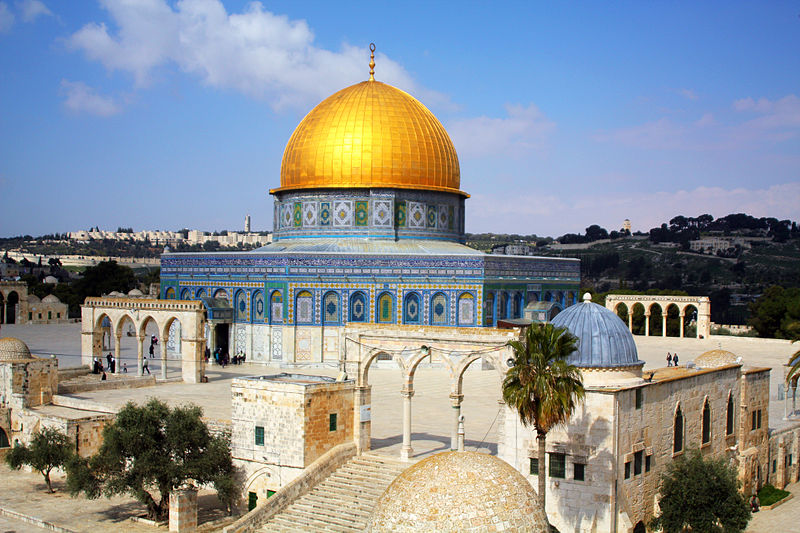
The Muslim Dome of the Rock is thought to sit on the spot where the Jewish First and Second Holy Temples were located.
These claims wash over writings less than a century old that were scribed by Jerusalem’s principal Muslim authority under the British Mandate.
In 1924, the Supreme Muslim Council wrote in A Brief Guide to al-Haram al-Sharif that the Temple Mount’s “identity with the site of Solomon’s Temple is beyond dispute. This, too, is the spot, according to universal belief, on which David built there an altar unto the Lord, and offered burnt offerings and peace offerings.” (Jewish Virtual Library)
The existence of Solomon’s Temple remained “beyond dispute” by Muslim rulers in pre-state Israel through the 1948 edition of the guidebook, the year Israel became a nation.
The next edition, in 1956, was published by Jordan’s Supreme Awqaf Council that took control and still administers the Temple Mount.
Whereas the Muslim Council’s goals admitted historical truth, it relegated the Jewish presence to the past and the Arab presence to now—the Jordanian goals were about “exercising and legitimizing Jordanian sovereignty over the Palestinians and the Haram al-Sharif [Temple Mount].”
Therefore, in the revised guide, no reference to the Jewish history of the Mount was made; the Western Wall was identified as “ancient, evidently Roman.” (Palestine’s Sacred Struggle, a thesis by Jennifer Koshner).
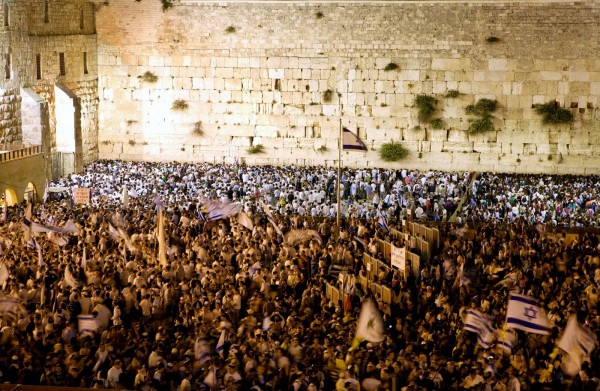
The Jewish People gather at the Western (Wailing) Wall in Jerusalem on Yom Yerushalayim. (Israel Tourism photo)
The Promise of God for Restoration
“Shouts of joy and victory resound in the tents of the righteous: ‘The Lord’s right hand has done mighty things! The Lord’s right hand is lifted high; the Lord’s right hand has done mighty things!'” (Psalm 118:15–16)
Increasingly in our time, the politics and the agendas of nations have focused on Jerusalem. This will likely intensify since its destiny is central to the Kingdom of Messiah on Earth.
While Jerusalem’s ultimate King will be righteous, Scripture lists both righteous and evil kings reigning in Judah, carrying behavioral influence over the entire kingdom, including its capital, Jerusalem. In fact, Scripture often seems to depict Israel adhering to the morality of its rulers—whether in repentance or in rebellion.
Before the discovery of the Torah scrolls by righteous King Josiah as he restored God’s Temple, King Manasseh made Jerusalem flush with evil, provoking the Lord to vow “such disaster on Jerusalem and Judah that the ears of everyone who hears of it will tingle.” (2 Kings 21:12)
Beginning at age 12, and continuing for 55 years, Manasseh “followed the detestable practices of the nations the Lord had driven out before the Israelites,” including building an Asherah pole and altars for Baal, bowing to the stars and building altars for them in the Lord’s Temple. In addition, “he sacrificed his own son in the fire, practiced divination, sought omens, and consulted mediums and spiritists.” (2 Kings 21:6)
“Manasseh also shed so much innocent blood that he filled Jerusalem from end to end—besides the sin that he had caused Judah to commit, so that they did evil in the eyes of the Lord.” (2 Kings 21:16)
While the sins of Manasseh led to the siege of Jerusalem by Nebuchadnezzar and the exile of the Jews into Babylon (2 Kings 24), God in His mercy promised Jerusalem’s cleansing and restoration:
“I will strengthen Judah and save the tribes of Joseph. I will restore them because I have compassion on them. They will be as though I had not rejected them, for I am the Lord their God and I will answer them. … On that day a fountain will be opened to the house of David and the inhabitants of Jerusalem, to cleanse them from sin and impurity.” (Zechariah 10:6, 13:1)
Even though God’s Chosen People defiled themselves and God’s Land many times, He has made numerous promises like those in Zechariah speaking of restoration of His People and of His Land.
On the other hand, there are no such promises for foreigners who try to defile His People and His Land. These enemies will be consumed with the wrath of God:
“In an instant, the Lord Almighty will come with thunder and earthquake and great noise, with windstorm and tempest and flames of a devouring fire. Then the hordes of all the nations that fight against Ariel, that attack her and her fortress and besiege her, will be as it is with a dream, with a vision in the night—as when a hungry person dreams of eating, but awakens hungry still. So will it be with the hordes of all the nations that fight against Mount Zion.” (Isaiah 29:6–8)
1948, 1967: The Arab League Rejects the Jewish State
The modern-day “fight against Mount Zion” that the Prophet Isaiah wrote about began politically with the Arab League’s repeated refusals to recognize a Jewish state.
Even so, on July 24, 1922, all 51 members of the League of Nations had already recognized “the historical connection of the Jewish people with Palestine and to the grounds for reconstituting their national home in that country.” (The Palestine Mandate, available at Yale Law School online)
That July, the Kingdom of Jordan did not yet exist; only in September did the League even draw up the potential borders of a new nation for Arabs residing in the British Mandate—to be established in Trans-Jordan (“across the Jordan River”).
With the land west of the Jordan still assigned to Palestinian Jews, the League’s plans separated out two-thirds of the Mandate—all east of the River—for Palestinian Arabs who were primarily comprised of Syrians and Saudi Arabians.
Despite propaganda claims today that Israel violates international law and acts as an occupier of “Arab Palestinian” lands, the nations themselves recognized the territory of Palestine west of the Jordan River—including Jerusalem, Gaza and Judea-Samaria—as constituting the Jewish homeland. (UnitedJerusalem)
Nevertheless, the Arab League’s rigid refusal to recognize a Jewish state brought heavy-handed violence against the minutes-old State of Israel in 1948. As a result, the Hashemite Kingdom of Jordan—also newly independent—seized eastern Jerusalem and Judea-Samaria.
In this greedy land grab, those areas come to be known as Jordan’s “West Bank.”

Between 1946 and 1948, the British Mandatory administration used barbed wire to secure and fortify key British installations, preventing Jewish and Arab movement. On Friday, May 14, 1948, the British Mandate ended and British forces withdrew. Israeli Irgun forces quickly took control of buildings that the British had nationalized.
In the years after Israel’s declaration of independence, even during the so-called armistice with the Kingdom of Jordan, foreign attackers—a large number Jordanian—continued striking against Israeli civilians with acts of rape, gunfire, grenade strikes, land mines and ambushes.
During the 1950s and ’60s, “border conflicts” against some of Israel’s 2.5 million Jews were common. In 1964, the Arab League created the Palestinian Liberation Organization (PLO). Over the course of three years, it issued dozens of terrorist raids against Israeli civilians.
In 1965, the PLO conducted 35 terrorist raids against Israelis, followed by 41 the next year and another 37 in 1967. The attacks against Israel peaked with the 1967 War. While outnumbered and under-equipped, the Jewish state fought against the four well-supplied invading armies—their 465,000 troops to Israel’s 264,000; 2,880 tanks to Israel’s 800; and 900 aircraft to Israel’s 300.
Amidst Israel’s immense physical disadvantages, God intervened on her behalf; the miracle of Israel’s win in the Six Day War proved God’s might through Israel’s lack—as if God was using it to show, “My grace is sufficient for you, for my power is made perfect in weakness.” (2 Corinthians 12:9)
We see a similar victory during the age of the judges when the Lord ensured that the army of Gideon, which would fight against the Midianites, would be small in number—selecting only 300 men of an initial 32,000 troops gathered. The Lord said to Gideon, “You have too many men. I cannot deliver Midian into their hands, or Israel would boast against me, ‘My own strength has saved me.'” (Judges 7:2)
So too, in June 1967, did God save Israel.
With every other support stripped away, the 19-year old nation was struck with overwhelming fear. The government estimated losses would be from 10,000 people to total annihilation, and started to convert national parks into mass burial grounds. (TheChurchesofGod)
The first PLO chairman, Ahmad Shukeiri, was reported saying on June 1, “This is a fight for the homeland; it is either us or the Israelis. … Any of the old Palestine-Jewish population who survive may stay, but it is my impression that none of them will survive.” (Association for Diplomatic Studies and Training)
Adding to Israel’s isolation, on June 5—the first day of the war—the US state department issued to the press their stance on the intensifying situation: “Our position is neutral in thought, word and deed.”
Not long before, on May 22, Egypt’s President Gamal Nasser had illegally closed the Straits of Tiran—an international waterway—to Israeli shipping, isolating the Israeli port of Eilat. Israel had informed Nasser that doing so would be considered a casus belli, “an act or situation provoking or justifying war.”
A week prior, on May 14, Nasser had asked United Nations Secretary General U Thant to withdraw the United Nations Emergency Forces deployed to the Sinai Peninsula; the UNEF forces exited the area two days later.
Already in 1965, Nasser had said multiple times that the goal of the Arab nations was “the full restoration of the rights of the Palestinian people.” He did not disguise the intent to wipe Israel off the map (nor do Israel’s current enemies).
“In other words, we aim at the destruction of the state of Israel. The immediate aim: perfection of Arab military might. The national aim: the eradication of Israel,” he said. (Jewish Virtual Library)

Nasser (center), King Hussein of Jordan (left) and Egyptian Army Chief of Staff Abdel Hakim Amer (right) at the Supreme Command of the Armed Forces headquarters in Cairo before signing a mutual defense pact, 30 May 1967.
By the summer of 1967, Nasser was goading Israel to war on a daily basis, stating “the Arab people want to fight.” Then, near the tipping point of war on May 30, Egypt signed a Mutual Defense Pact with Jordan.
“Our basic objective will be the destruction of Israel,” Nasser said. “We will not accept any … coexistence with Israel.”
In response to the provocation, Israel preemptively struck the Egyptian forces amassing in the Sinai at Israel’s border. Despite the overwhelming superiority of enemy forces, it proved to be a massive win for the Jewish state. Israel secured the Sinai Peninsula and Gaza (occupied by Egypt since 1948); Judea, Samaria and the Old City of Jerusalem (occupied by Jordan since 1949); and the Golan Heights held by Syria.
Against all advice by National Security Advisor Kissinger and Secretary of Defense Schlesinger; in spite of economic retaliation by Arab nations; and despite his own hostilities toward certain Jewish influence, US President Nixon ordered a complete replenishing of military supplies to Israel.
“Over the course of the airlift 567 missions were flown, delivering over 22,000 tons of supplies, and an additional 90,000 tons were delivered to Israel by sea,” writes Roger Stone in his book Nixon’s Secrets. (p. 399)
Upon entering eastern Jerusalem, the troops found a sore sight. The Jordanian forces that had possessed the Old City for 19 years caused the city to fester—destroying, looting and desecrating 58 synagogues in her midst, ransacking the Jewish cemetery on the Mount of Olives and trampling the Temple Mount.
Moreover, in direct violation of the 1949 armistice agreements, Jordan had denied the Jewish People access to the Mount of Olives cemetery, as well as to Jerusalem’s Jewish religious sites—including the Western Wall. Under Jordan’s neglect, the iconic prayer site was reduced to a slum. Jordan also cut off Israeli Arabs from accessing the Dome of the Rock and the Al-Aqsa mosque.
While, for the most part, Christians could access their holy sites, Christian schools were required to teaching all students the Koran and no Christian material could be taught to non-Christians. (SixDayWar)
The Physical and Spiritual Warfare Continues
Today, Israel’s enemies still deny her historical and legal authority over a reunited Jerusalem and even her existence as a nation.
So, too, does Satan (the “Adversary”) try to deny the truth of God’s existence and His authority over the Land of Israel. In fact, it is possible to draw parallels between the anti-Semitic propaganda that slanders Israel and the satanic lies spewed against her God on a daily basis.
We even see an image of Satan on the public Facebook page of an official student council officer from Durban University of Technology’s Student Representative Council, who announced: “We [the council] took the decision that Jewish students, especially those who do not support the Palestinian struggle, should deregister.”
Hate-filled rhetoric like this is prominent on campuses throughout the world. It is especially intense during the annual Apartheid Week.
Yet, God’s permanent covenant with the Jewish people, with the Land of Israel, and with the City of Jerusalem as laid out in His Word, flourishes today in full view of “those who have eyes to see.”
God’s love relationship with Israel, built on the foundation of a binding covenant, demonstrates the truth of His Word, as well as the reliability of His love and His promises to all nations.




